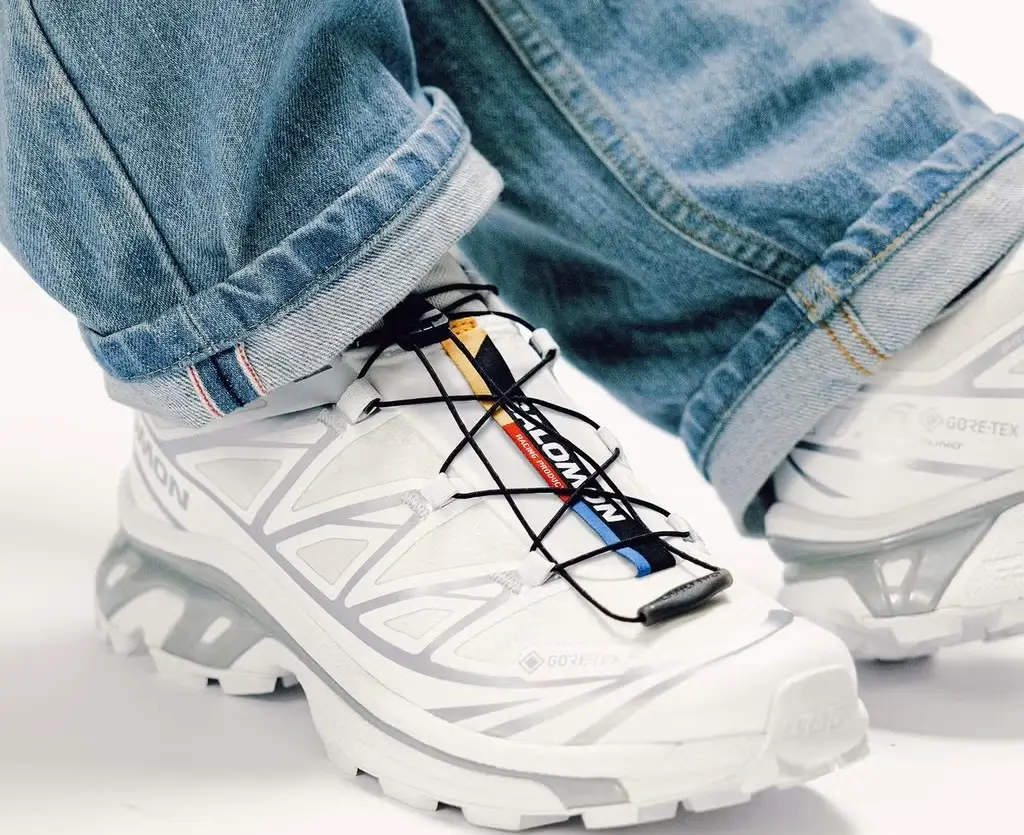Few shoes have reached the level of cultural reverence as the Nike Air Mag, a sneaker that first appeared on the silver screen in 1989’s “Back to the Future Part II” and later became a real-life, highly coveted piece of footwear. With its futuristic design, glowing LED lights, and self-lacing technology, the Air Mag was originally conceived as part of a fictional future—a symbol of technological advancement in the year 2015 as imagined in the 1980s. However, more than three decades after its initial appearance, the Air Mag has evolved into a symbol of innovation, nostalgia, and exclusivity in sneaker culture.
The Air Mag made its first appearance on screen in “Back to the Future Part II”, when Marty McFly, played by Michael J. Fox, travels to the future—specifically, the year 2015. Upon arriving in this futuristic world, Marty dons a pair of Nikes that seem to defy the laws of physics: the shoes not only light up but also lace themselves automatically at the touch of a button. This moment became iconic, not just for fans of the film but also for sneakerheads and tech enthusiasts alike. The idea of a self-lacing shoe captured the imagination of a generation, symbolizing the limitless possibilities of future technology.
At the time, the Air Mag was just a prop, a vision of what footwear might look like in the distant future. Yet, even as a fictional item, the shoe resonated with audiences on a deeper level. Its futuristic design, combined with the popularity of the “Back to the Future” franchise, embedded the Air Mag into pop culture. For years, fans speculated about whether Nike would ever bring this shoe to life, creating a mythos around the sneaker that only grew as time went on.
Bringing Fiction to Reality: The Nike Air Mag Becomes Real
It wasn’t until 2011, more than two decades after the release of “Back to the Future Part II”, that Nike finally made the Air Mag a reality. In a highly publicized move, Nike released a limited run of 1,500 pairs of the Air Mag, which were auctioned off to benefit the Michael J. Fox Foundation for Parkinson’s Research. This release was momentous, not only because it brought to life a beloved piece of film history but also because it connected the shoe to a meaningful cause, raising millions for Parkinson’s research.
The 2011 Air Mags, while visually identical to their cinematic counterpart, lacked the self-lacing technology that made the original shoe so famous. Nonetheless, the sneaker community was ecstatic. The release of the Air Mag marked a turning point in sneaker culture, showcasing how a product could be both a fashion item and a symbol of technological aspiration. The sneaker’s scarcity, combined with its deep ties to pop culture, made it one of the most desirable shoes in history, with some pairs selling for over $50,000 at auction.
Then, in 2016, Nike released a second version of the Air Mag, this time featuring the self-lacing technology that fans had long dreamed of. The 2016 Air Mags were even more exclusive, with only 89 pairs being produced—an homage to the year *Back to the Future Part II* was released. Once again, these sneakers were auctioned off to benefit the Michael J. Fox Foundation, further solidifying the Air Mag’s legacy as both a cultural and philanthropic icon.
The Power of Self-Lacing
One of the most remarkable aspects of the Nike Air Mag is its self-lacing feature, known officially as Nike’s “Adaptive Fit” technology. In the 2016 release, this technology allowed the shoe’s laces to automatically tighten and adjust to the wearer’s foot, achieving what seemed like science fiction when it was first imagined in the late 1980s. While this technology was limited to the Air Mag at the time of its release, it paved the way for the future of footwear, signaling Nike’s commitment to blending technology with fashion.
In fact, Nike’s work on the Air Mag’s self-lacing technology led to the development of the HyperAdapt 1.0, a performance shoe released in 2016 that also featured Adaptive Fit technology. The HyperAdapt 1.0 was the first widely available Nike shoe with self-lacing capabilities, offering a glimpse of what the future of sneaker innovation might look like. The evolution from the Air Mag to the HyperAdapt demonstrates how a fictional concept from a 1980s movie influenced real-world technological advancements in athletic footwear.
The introduction of self-lacing technology is more than just a gimmick—it represents a shift in how we think about functional fashion. The ability for shoes to automatically adjust their fit has practical applications beyond mere aesthetics. For athletes, Adaptive Fit technology can provide a customized, snug fit that enhances performance. For individuals with disabilities, self-lacing shoes could offer greater ease of use, eliminating the need to manually tie laces. While the Air Mag may have started as a fantasy shoe, its real-world implications are far-reaching and significant.
The Air Mag as a Symbol of Nostalgia
Beyond its technological innovation, the Air Mag is perhaps most notable for its role in tapping into a powerful sense of nostalgia. In recent years, nostalgia has become a driving force in consumer culture, with brands reviving products, styles, and even media from the 1980s and 1990s to cater to audiences longing for the past. The Air Mag is a perfect example of this phenomenon: it’s a shoe that appeals not only to sneakerheads and collectors but also to fans of *Back to the Future*, many of whom grew up with the film and see the shoe as a tangible link to their childhood.
The Air Mag’s status as a nostalgic artifact is amplified by the fact that it was originally a fictional item. In bringing the shoe to life, Nike created a bridge between the imagined future of the 1980s and the actual future of the 2010s. For many, the Air Mag represents a dream come true—a piece of their favorite movie made real, and with it, the promise of a more exciting, technologically advanced world. This blending of nostalgia and futurism is what makes the Air Mag so special: it’s a product of the past, present, and future all at once.
Moreover, the Air Mag’s association with “Back to the Future” ties it to broader cultural themes of time travel, progress, and the idea of what the future might hold. In the 1980s, the year 2015 seemed like a distant utopia filled with flying cars, hoverboards, and self-lacing shoes. While many of the futuristic predictions from “Back to the Future Part II” have yet to come true, the Air Mag stands as a symbol of how far technology has come—and how much further it can go.
Another key aspect of the Air Mag’s cultural impact is its rarity and exclusivity. Both the 2011 and 2016 releases were produced in extremely limited quantities, making the Air Mag one of the most coveted sneakers in the world. For sneaker collectors, owning a pair of Air Mags is a status symbol, a sign that they are part of an elite group with access to one of the most iconic shoes ever made.
This exclusivity has fueled the hype around the Air Mag, driving prices on the resale market to astronomical heights. Some pairs have sold for over six figures, making the Air Mag not just a sneaker but a high-value collectible. This phenomenon is emblematic of the broader trends in sneaker culture, where limited-edition releases and collaborations create a sense of scarcity and desirability that drives demand.
The Air Mag’s status as a luxury item also speaks to the intersection of fashion and technology. In the 21st century, high-end fashion is increasingly about more than just aesthetics—it’s about innovation, storytelling, and exclusivity. The Air Mag embodies all of these qualities, making it a unique product that transcends the typical boundaries of sneaker design.
Impression
More than 30 years after its initial appearance in “Back to the Future Part II”, the Nike Air Mag remains a cultural touchstone. Its influence can be seen not only in the world of sneaker culture but also in the broader conversation about technology, innovation, and nostalgia. The Air Mag represents the power of pop culture to shape real-world products, as well as the enduring appeal of futuristic design.
In many ways, the Air Mag is more than just a shoe—it’s a symbol of aspiration. It reminds us of the dreams we once had for the future and the ways in which technology can make those dreams a reality. Whether it’s through self-lacing technology, its philanthropic connections to the Michael J. Fox Foundation, or its role as a cultural icon, the Air Mag continues to inspire both sneakerheads and dreamers alike.
As we look to the future of fashion and technology, the Air Mag will likely remain a key reference point, a reminder of how one moment in a film can spark decades of innovation and cultural influence. The shoe’s legacy is a testament to the power of imagination, and its place in sneaker history is firmly cemented as one of the most iconic and influential shoes ever made.
The Nike Air Mag has transcended its origins as a fictional prop to become a real-world symbol of innovation, exclusivity, and nostalgia. Its self-lacing technology, association with “Back to the Future”, and limited availability have made it one of the most coveted sneakers in history, while its connection to the Michael J. Fox Foundation has given it a philanthropic legacy as well. In many ways, the Air Mag represents the intersection of fashion, technology, and culture, standing as a testament to the power of imagination and the ways in which pop culture can shape the future.
As we continue to explore the possibilities of technology in fashion, the Air Mag will remain a beacon of what can be achieved when creativity and innovation come together. Its place in sneaker culture is secure, but its influence reaches far beyond the world of footwear, serving as a symbol of the future we once imagined—and the future we are still working to create.
No comments yet.








